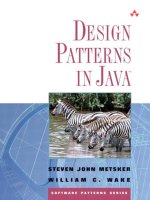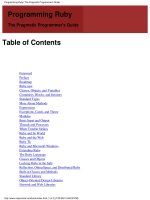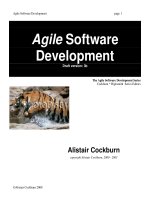Addison wesley embedded linux hardware software and interfacing mar 2002 ISBN 0672322269
Bạn đang xem bản rút gọn của tài liệu. Xem và tải ngay bản đầy đủ của tài liệu tại đây (2.1 MB, 505 trang )
EmbeddedLinux®:Hardware,Software,and
Interfacing
ByCraigHollabaughPh.D.
Publisher :AddisonWesley
PubDate :March07,2002
ISBN :0-672-32226-9
Pages :432
Slots :1.0
EmbeddedLinuxcoversthedevelopmentand
implementationofinterfacingapplicationsonanembedded
Linuxplatform.Itincludesacomprehensivediscussionof
platformselection,crosscompilation,kernelcompilation,
rootfilesystemcreation,booting,remotedebugging,realworldinterfacing,applicationcontrol,datacollection,
Tableof archiving,andpresentation.
•
Contents
Thisbookincludesserial,parallel,memoryI/O,USB,and
•
interrupt-drivenhardwaredesignsusingx86-,
StrongARM®-,andPowerPC®-basedtargetboards.In
addition,youwillfindsimpledevicedrivermodulecode
thatconnectsexternaldevicestothekernel,andnetwork
integrationcodethatconnectsembeddedLinuxfield
devicestoacentralizedcontrolcenter.Examplesteach
hardwaredevelopershowtostoreandactivatefieldbitsand
deliverprocessinformationusingopensourcesoftware.If
youareahardwaredeveloper,softwaredeveloper,system
integrator,orproductmanagerwho'sbegunexploring
embeddedLinuxforinterfacingapplications,thisbookis
foryou.
EmbeddedLinux®:Hardware,Software,and
Interfacing
ByCraigHollabaughPh.D.
Publisher :AddisonWesley
PubDate :March07,2002
ISBN :0-672-32226-9
Pages :432
•
Tableof
Contents
•
Slots :1.0
Copyright
Foreword
AbouttheAuthor
Acknowledgments
Introduction
BenefitsofThisBook
WhatThisBookCovers
WhoThisBookIsFor
ConventionsUsedinThisBook
PartI:
GettingStarted
Chapter1.
IntroducingEmbeddedLinux
WhyLinux,WhyNow?
WhatIsanEmbeddedSystem?
WhatDoesReal-TimeMean?
ImplicationsofOpenSource
Summary
AdditionalReading
Chapter2.
SystemArchitecture
IntroducingProjectTrailblazer
TheSilverjackResortLayout
ProjectTrailblazerRequirements
TheProjectTrailblazerSystemArchitecture
Summary
Chapter3.
SelectingaPlatformandInstallingToolSets
SourcesofInformation
TheProjectTrailblazerStrategicDirection
Buildingtbdev1,theEmbeddedLinuxDevelopment
Workstation
Summary
AdditionalReading
Chapter4.
BootingLinux
TheTargetPBRs
TheLinuxBootProcess
TheLinuxrootFilesystem
CreatingtherootFilesystem
InstallingtheTFTPServer
Installingminicom
BootingtheEmbeddedPlanetRPX-CLLF
BootingtheBrightstarEngineeringMediaEngine
BootingtheTri-MMZ104andtheCOTSPCwithaFlashIDE
Drive
BootComparison
Summary
AdditionalReading
Chapter5.
Debugging
Introducinggdb
LocalDebugging
RemoteDebugging
Network-MountingtherootFilesystem
Summary
AdditionalReading
PartII:
Interfacing
Chapter6.
AsynchronousSerialCommunicationInterfacing
TheProjectTrailblazerAsynchronousSerialHardware
DevelopmentEnvironment
LinuxSerialCommunications
Summary
AdditionalReading
Chapter7.
ParallelPortInterfacing
ControlUsingtheParallelPort
StandardParallelPortControlwithPortI/O
StandardParallelPortControlUsingppdev
DevelopingaCustomDeviceDriver
StandardParallelPortControlUsingtheCustomDeviceDriver
liftmon_snowcon
Summary
AdditionalReading
Chapter8.
USBInterfacing
LearningAboutUSB
ProjectTrailblazerUSBHardware
Summary
AdditionalReading
Chapter9.
MemoryI/OInterfacing
TheHardwareDesignProcess
DevelopingLiftMonitoringandSnow-MakingControlforthe
MediaEngine
DevelopingLiftMonitoringandSnow-MakingControlforthe
RPX-CLLF
Summary
AdditionalReading
Chapter10.
SynchronousSerialCommunicationInterfacing
TemperatureSensingandDisplay
SPICommunicationandtheLM70
I2CCommunicationwiththePhilipsSemiconductorSAA1064
Summary
AdditionalReading
Chapter11.
UsingInterruptsForTiming
LinuxTimingSources
MeasuringInterruptLatency
ImplementingtheRaceTimer
Summary
AdditionalReading
Chapter12.
SystemIntegration
IntegrationOverview
InstallingtheSystemIntegrationApplications
CreatingandTestingtheProjectTrailblazerDatabase
DevelopingtheTargetandCGIIntegrationScripts
Summary
AdditionalReading
Chapter13.
FinalThoughts
GUIDevelopment
Real-timeCapabilities
TheEmbeddedLinuxVendorOfferings
ProjectTrailblazerHardware
Summary
AdditionalReading
Top
Copyright
Manyofthedesignationsusedbymanufacturersandsellerstodistinguishtheir
productsareclaimedastrademarks.Wherethosedesignationsappearinthis
book,andAddison-Wesleywereawareofatrademarkclaim,thedesignations
havebeenprintedininitialcapitallettersorinallcapitals.
Theauthorandpublisherhavetakencareinthepreparationofthisbook,but
makenoexpressedorimpliedwarrantyofanykindandassumeno
responsibilityforerrorsoromissions.Noliabilityisassumedforincidentalor
consequentialdamagesinconnectionwithorarisingoutoftheuseofthe
informationorprogramscontainedherein.
Thepublisheroffersdiscountsonthisbookwhenorderedinquantityforspecial
sales.
Formoreinformation,pleasecontact:
PearsonEducationCorporateSalesDivision201W.103rdStreet
Indianapolis,IN46290
(800)428-5331
VisitAWontheWeb:www.awl.com/cseng/
Copyright©2002byPearsonEducation
Allrightsreserved.Nopartofthispublicationmaybereproduced,storedina
retrievalsystem,ortransmitted,inanyformorbyanymeans,electronic,
mechanical,photocopying,recording,orother-wise,withoutthepriorconsent
ofthepublisher.PrintedintheUnitedStatesofAmerica.Published
simultaneouslyinCanada.
LibraryofCongressCatalogCardNumber2001089582
Textprintedonrecycledpaper
12345678910—CRS—05040302
Firstprinting,March2002
Credits
AssociatePublisherJeffKoch
AcquisitionsEditorKatiePurdum
DevelopmentEditorMarkCierzniak
ManagingEditorMattPurcell
ProjectEditorAndrewBeaster
CopyEditor
KittyWilsonJarrett
Indexer
KenJohnson
Proofreader
JuliCook
TechnicalEditorRobSavoye
TeamCoordinatorDenniBannister
InteriorDesignerAnneJones
CoverDesignerArenHowell
PageLayout
MarkWalchle
AyannaLacey
MichelleMitchell
Dedication
Formysupportstaff,theSpuds:KathyandChrisAnderson,CaelaandSteve
Bova,MelanieandScottClemmons,PamandRobertCort,TinaDittmar,
JonathanFulford,TanyaandKevinHansel,MargaretHollabaugh,Maureenand
SteveJett,ScottKidner,BrianKopp,TeresaLoconte,MichelleandBrad
Lohrding,DarlaandAlfredLorber,VenitaandCraigLujan,JeanandJohn
McLennan,MarceMiller,LisaandJimOlwine,KatiePurdum,AnnaandMike
Sadler,JenniferandFritzSiegrist,KarenandJohnTotten,KarynYoung,and
especiallyMelanieKline.
Top
Foreword
Embeddedsystems,theonce-sleepybackwaterofinformationtechnology,are
nowemergingasamultibillion-dollarindustrythatisalreadypervadingour
everydayexistencesandchangingourlives.Aroundtheworld,"smartdevices"
areinsinuatingthemselvesintoeveryone'sdailyroutine:Youdrivetoworkin
yourelectronicallycontrolledcarorrideadigitallyguidedcommutertrain,take
acallonyourmobilephone,makecopiesattheoffice,sitinonadigital
conferencecall,andthengohomeandwatchamoviefromyourcableboxor
DVDplayer.Ifyoulookaroundyou,you'llrealizethat50to100embedded
computerstouchyourlifeeveryday.
Linuxistakingthisworldofembeddedandpervasivecomputingbystorm.
Oncedominatedbyproprietaryandobscureoperatingsystems,tools,and
applications,embeddeddesignstodaybenefitfromthetransparencyand
functionalityofopen-sourcesoftware,especiallyLinux.Evenconservative
estimatesshowembeddedLinuxgarneringuptohalfofallnewembedded
designsbytheendof2002.
InmyroleatMontaVistaSoftware,Ihavethepleasureoftalkingtothousands
ofembeddeddevelopersandofsneakingglimpsesintotheirvariedprojects.In
thiscontextIfirstmetDr.CraigHollabaughatLinuxWorldinNewYorkin
2001.Inthecourseofhiswritingthisbook,Ihadthepleasureofhiscompany
severalmoretimesandnumerouschatsbyphone.
IfindCraig'sapproachbothsensibleandcomprehensive.Hischoiceofan
applicationtorunthefabledSilverjackwinterresortbothrecallsthe"meatand
potatoes"oftheembeddedapplicationsspace(controlandinstrumentation)and
launchesintotoday'shotnewareasofpervasivecomputing(embeddedWeb
interfacing,multimedia,andmessaging).Hissurveyofavailableembedded
hardwareandkeyinterfacetechnologiesandhisstep-by-stepaccountofthe
embeddedLinuxdevelopmentprocessprovideinvaluablesignpostsforaspiring
systemdesigners.
Craig'steamoftrailblazingengineersconfrontedthedauntingtaskofacquiring
andusingembeddedLinuxdevelopmenttoolsanddeploymentcomponents.
TheSilverjackscenarioandthedetailsoftheengineeringeffortmirrorthe
experiencesofmanydevelopersfacingtheirfirstembeddedLinuxproject.The
slopeissteep,buttherewardsareverygreat.BookslikeEmbeddedLinux;
organizationsliketheEmbeddedLinuxConsortium,EMBLIX,and
LinuxDevices;andtheeffortsofembeddedLinuxplatformvendorsclearapath
tosuccessfuldevelopmentanddeploymentofthenextgenerationofsmart,
Linux-baseddevices.
WilliamWeinberg
DirectorofStrategicMarketing/EmbeddedLinuxEvangelist
MontaVistaSoftware
SanJose,CA
January2002
Top
AbouttheAuthor
CraigHollabaughhasbeenfascinatedbyelectronicssinceheboughtanAM
radioinelementaryschool.HewasfirstexposedtoUnixduringacross-country
talksessionin1985.Later,headministerednetworkedSunandDEC
workstationswhilepursuingadoctoraldegreeinelectricalengineeringat
GeorgiaInstituteofTechnology.
Craig'sfirstembeddedSCADA(supervisorycontrolanddataacquisition)
design,thePacMeister,remotelymonitoredthegasolineadditiveinjection
processandearnedhimaU.S.patent.Hisnextembeddeddesign,theTitan
PAC-3,basedonIntelx86architecture,controlledthisinjectionprocess,usinga
home-growthmultitaskingoperatingsystemwritteninC++,completewithboot
code,communicationsability,andfield-downloadableapplicationcode.
In1995Craigco-foundedWirelessScientific,wherehedeveloped20spreadspectrum900MHzISMindustrialtelemetryproducts.Craigworkedwithmore
than200developers,systemsintegrators,andequipmentmanufacturersto
incorporatewirelesstelemetrywithintheirSCADAapplicationsorproduct
lines.In1996WirelessScientific'sGlobalDataManagementprojectusedLinux
asadevelopmentplatformtoremotelymonitorandcontroladditivetanklevels.
In1997LanierCorporationchargedCraigwitharchitectingitsnext-generation
VoiceWriter,amedicaldigitaldictationandtranscriptionsystemwithrevenues
beyond$100million.Hisresponsibilitiesincludedensuringthatproduct
developmentfollowedcurrent/futuretechnologicaltrends,adheredto
technical/medicalinformationstandards,andincorporatedLanier'slegacy
products.
CraigconsultsfromhishomeinOuray,Colorado.Hedevelopedthefirmware
forAntec'sflagshipcabledistributionproduct,theProteusScalableNode.At
Clifton,WeissandAssociates,Craigisamemberofacarrier-class
telecommunicationsnetworkdesignteam.Hiscurrentresponsibilitiesinvolve
designingandanalyzingwiredandwirelessvoiceanddatanetworksforDallas
AreaRapidTransit,MetroNorthRailroad,NewYorkCityTransit,and
PittsburghAreaTransit.He'salsodesigningFM,MP3,andBluetoothheadset
electronicsforArriva.
TheOuraycommunitybenefitsthroughCraig'ssystemadministrationsupport
ofOuraynetandhisadulteducationclassesinelectronicsandprogramming.
Mostrecently,Craigco-foundedTheSilverjackBakingCompany,wherehe
willbakeandsellscrumptiousdelightsfromahorse-drawnbakerywagonon
Ouray'sMainStreetduringthesummermonths.Ifthere'ssnowflying,you'll
mostlikelyfindhimsnowboardingatTelluride.
Top
Acknowledgments
Theenthusiasmtowardthisbookhasbeensimplyphenomenal.EveryoneI
mentionittohassupportedmyeffortsinsomeway.I'dliketostartbythanking
afewpeoplewhohelpedmetoseemygreatness:KatiePurdum,Angelo
d'Amelio,RogerSmith,GerriSpina,EvaMontibello,andTeresaLoconte.
Theseday-to-daysupportersthentookoverandcontinuedthepush:Melanie
Kline,JoshKline,MouseandHarryDurgin,PaulVallejos,BenBlouse,Scott
Kidner,BrianKopp,andmylittlebabysister,KarenTotten.Iattributethe
book'sreadabilitytomyeditingteam:JohnHollabaugh,RobSavoye,Kitty
Jarrett,andMarkCierzniak.AspecialthankstoRickLehrbaum,forhis
comprehensiveembeddedLinuxWebsite,linuxdevices.com.Iwanttothank
theseindividualsatcompaniesthatofferedtheirproductsandtechnicalsupport
forthebook'sexamples:DougSteadatTri-MSystems,StuartAdamsat
BrightstarEngineering,KenApplebaum,JohnHavre,andMattHooverat
EmbeddedPlanet,EugeneFengatSiliconStorageTechnology,JuanVazquezat
ESPTech,TomBarnumatVersaLogic,andBillWeinburgatMontaVista
Software.Theworkoftheseindividualsalsocontributedtotheexamples:
ThomasOehser,ErikMouw,OriPomerantz,AlessandroRubini,Jonathan
Corbet,TimWaugh,JanAxelson,CraigPeacock,RikuSaikkonen,JensGecius,
DetlefFliegl,BradHards,MarkPilon,DanielSmolik,MarkusSchlup,Michael
Hipp,DavidBeal,WolfgangDenk,MarkHatle,DanMalek,LarryDoolittle,
andJimReady.Theseopen-sourcedevelopersdeserveatremendous
acknowledgementfortheiractivities:allthekernelprogrammers,Debian,
ApacheSoftwareFoundation,MySQL,andGNU.Thisbookexistsbecauseof
yourcontributions,support,andencouragement.Ithankyou.
Top
Introduction
Thisisanexcitingtime.TheproliferationofInternettechnologyhas
transformedourconceptofinformation.24hoursperday,peoplerelyon
networkdevicesforbusinessandpersonaluse.Overtime,thisdependencewill
growfurther.Today'snetworkdevices,suchasservers,routers,anddesktop
computers,formtheInternet'sinfrastructure.Tomorrow'sdeviceswillcontrol
yourhome'stemperature,maintaininventorylevelsatyourbusiness,and
monitorautomobiletrafficpatterns.Onlyahandfulofthebillionsofprocessors
producedeachyeargointodesktoporservercomputers.Theremaining
processorsmonitorandcontrolotherfacetsoftheworld.
Individualsandbusinesseswantsmart,network-connected,devicestoimprove
theirlives,theirefficiency,andtheirbottomdollar.Thesedevicesmustbe
simpletooperate,reliable,andinexpensive.ThisiswhereLinuxcomesin.
AdvancesintechnologyaccompaniedbycompetitivepricingallowLinuxto
movefromthedesktopandserverenvironmenttoembeddeddevices.Linux
offersreliability,features,open-sourcecode,andaproventrackrecord;these
featuresmakeitperfectlysuitedforembeddedsystemdesigns.Inthisbook,you
willfindinformationtocreateanembeddedLinuxfoundation.Youcanthen
extendthisfoundationinyourowndesigns.
Top
BenefitsofThisBook
WhenIfirststartedresearchingmaterialforthisbook,Iassumedthatonline
embeddedLinuxinformationwaslikeotherLinuxinformation—plentifuland
welldocumented.Iquicklydiscoveredthatmyassumptionwaswrong.Ifound
embeddedLinuxdocumentationtobesparse,scattered,incomplete,and
sometimesdated.Thiswasdiscouragingandinvigoratingatthesametime.
AlthoughIworriedaboutbeingabletofindadequateinformation,Iwasfurther
convincedoftheneedforthisbook.Peoplearedesigningembeddedproducts
withLinux,sotheinformationandknowledgeareoutthere;itjusthasn'tall
beeninoneplaceuntilnow.
Asaninstructor,Ihavedeterminedthatstudentsbestunderstandandretain
theoreticalconceptsandideaswhenaccompaniedbyexamples.Whenstudents
seeaconceptinaction—whetheritisaroboticarmmovement,avoltmeter
reading,oranoscilloscopewaveform—they'remostlikelytolaterapplythat
concepttosolvetheirownproblems.That'swhythisbookisfullofstep-by-step
examples.Youwilllearnthroughtheexampleandbeabletoapplythat
knowledgetoyourowndesigns.
Top
WhatThisBookCovers
Thisbookincludesacompleteseriesofreal-worldinterfacingexamples
designedtointroduceembeddedLinuxfromhardwareandsoftware
perspectives.AfteryoucreateanembeddedLinuxdevelopmentenvironment,
youwillstepthroughhardwareandsoftwareinterfacingexamples,using
asynchronousserialcommunication,thePCparallelport,USB,memoryI/O,
synchronousserialcommunication,andinterrupts.Allinterfacingexamplesare
thentiedtogetherusingsystemintegration.Allthismaterialispresentedby
usingawinterresortautomationprojectcalledProjectTrailblazer.Youcanfind
thebook'ssourcecodeandscriptsatwww.embeddedlinuxinterfacing.com.
Thefollowingtextbrieflysummarizeseachchapter.
Chapter1,"IntroducingEmbeddedLinux,"describesthebriefhistoryofLinux
asanembeddedoperatingsystemandtheimplicationsofusingopen-source
softwareinproductdesign.
Chapter2,"SystemArchitecture,"introducesawinterresortautomationproject
calledProjectTrailblazeranddevelopsaseriesofprojectrequirements.Project
Trailblazeranditsrequirementsformthebasisforthebook'sinterfacing
examples.
Chapter3,"SelectingaPlatformandInstallingToolSets,"describestheprocess
ofplatformselection.Fourtargetboards—whichusex86,StrongARM,and
PowerPCprocessors—areselectedforProjectTrailblazer.Thischapterthen
describesthecreationofanembeddedLinuxdevelopmentworkstationcalled
tbdev1.Allthedevelopmenttoolsareeitherinstalledorcompiled,includingthe
cross-compiledtoolchainfortheStrongARMandPowerPCprocessors.
Chapter4,"BootingLinux,"describestheLinuxbootprocess,frompower-on
tothebashprompt.Usingaminimumrootfilesystem,eachtargetboardis
bootedusingLinuxversion2.4.
Chapter5,"Debugging,"configuresgdbandgdbserverfortargetboard
debuggingovertheEthernetnetwork.Across-compiledversionofhelloworld
isremotelyexecutedanddebugged.
Chapter6,"AsynchronousSerialCommunicationInterfacing,"describesthe
Linuxserialportdevicedriverforcontrolofportsignalsandbuffers.AnRFID
tagreader,anLCDdisplay,andcontrolcircuitryareinterfacedtotheLinux
serialport.
Chapter7,"ParallelPortInterfacing,"describesinterfacingACcircuitstoan
x86targetboard'sparallelprinterport.Acustomdevicedrivercalled
helloworld_proc_modulethatusesa/procdirectoryentryisintroduced.
Chapter8,"USBInterfacing,"describesconnectingacameraandspeakersfor
visualinputandaudiooutputtoatargetboard'sUSBport.
Chapter9,"MemoryI/OInterfacing,"describesinterfacingACcircuitstothe
StrongARMandPowerPCtargetboards'CPUbuses.
Chapter10,"SynchronousSerialCommunicationInterfacing,"describesSPI
andI2Cconnectionsandcommunications.Alow-costSPItemperaturesensor
andI2CLEDdisplaydriverareinterfacedtothetargetboards.
Chapter11,"UsingInterruptsforTiming,"describesLinuxtimingsourcesand
themeasurementofeachtargetboard'saverageinterruptlatency.Aneventtimer
with1msaccuracyisdevelopedtomeasureracetimes.
Chapter12,"SystemIntegration,"describesthecreationoftheProject
Trailblazerdatabase.Targetandserverbashscriptsaredeveloped,usingthis
databaseforcollectionanddistributionoftemperature,image,and
authenticationdata.
Chapter13,"FinalThoughts,"summarizestheinterfacingprojectsand
discussesembeddedLinuxtopicsthatarenotaddressedelsewhereinthebook.
Top
WhoThisBookIsFor
Ifyouareahardwareengineer,softwaredeveloper,systemintegrator,or
productmanagerwho'sbegunexploringembeddedLinuxforinterfacing
applications,thenthisbookisforyou.Thebook'scomprehensiveinterfacing
examplesaresimple,requiringonlyabasicunderstandingofdigitallogic
design,Candbashprogramming,andLinuxsystemadministration.
Top
ConventionsUsedinThisBook
ThisbookusesseveralcommonconventionstohelpteachembeddedLinux.
Thetypographicalconventionsusedinthisbookincludethefollowing:
Commandsandcomputeroutputappearinamonospacedcomputerfont.
Commandsyoutypeappearinaboldfacedcomputerfont.
Italicsareusedtointroduceyoutonewterms.
Inadditiontotypographicalconventions,thisbookincludestips,whichlook
likethis:
TIP
Informationthatoffersshortcutsandsolutionstocommonproblemsis
highlightedasatip.
Top
PartI:GettingStarted
INTHISPART
1IntroducingEmbeddedLinux
2SystemArchitecture
3SelectingaPlatformandInstallingToolSets
4BootingLinux
5Debugging
Top
Chapter1.IntroducingEmbeddedLinux
INTHISCHAPTER
WhyLinux,WhyNow?
WhatIsanEmbeddedSystem?
WhatDoesReal-TimeMean?
ImplicationsofOpenSource
AdditionalReading
SoyouwanttouseLinuxinyournextembeddedsystemdesign?Great!You're
notalone:Thousandsofdevelopersworldwidearedoingthesamething.Like
you,theywanttotakeadvantageofcountlesshoursofcodecreationtomake
theirproductsreliable,featurepacked,robust,andquicktomarket.Embedded
Linux—usingLinuxasanoperatingsysteminembeddeddevices—isnow
commonplace.In1999notmanydevelopersconsideredLinuxanoptionfor
embeddeddesigns.Today,however,Linuxiswellpoisedtobecomethemarket
leaderforembeddedoperatingsystems.
Inacoupleyears,it'slikelythatafairpercentageofthebillionsofprocessors
producedeveryyearwillrunLinux.ThemassiveInternetadoptionofLinux,
combinedwithtechnologyadvancesandpricereductionsinhardware(CPUs)
andmemory(bothflashandRAM),finallymakeembeddingLinuxaviable
option.Since1999useofembeddedLinuxhasgonefromzeroadoptionto
takingsecondplace,intermsofmarketshare,behindWindRiver.1Experts
estimatethatembeddedLinuxwilltakeoverthenumber-onemarketshare
positionbytheendof20021.Thisisveryinteresting,consideringthatLinux
actuallystartedasstudentprojectsomanyyearsago.Linuxcanbecomenumber
one,throughtheadoptionofembeddedLinuxfordesignsthatbecomeproducts.
Top









